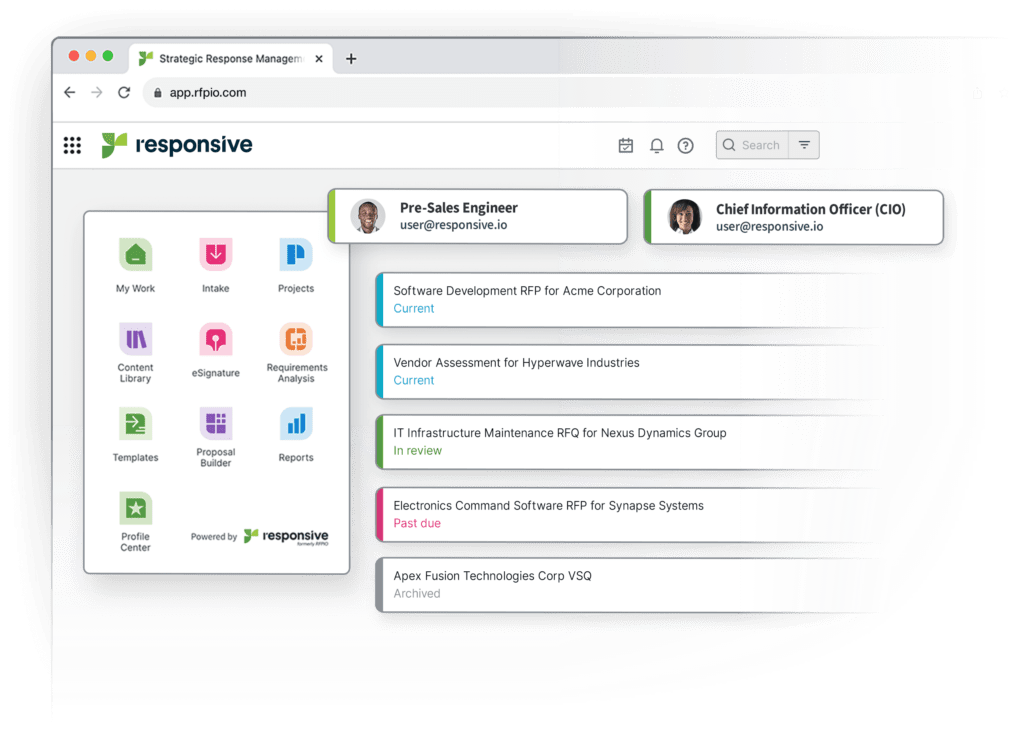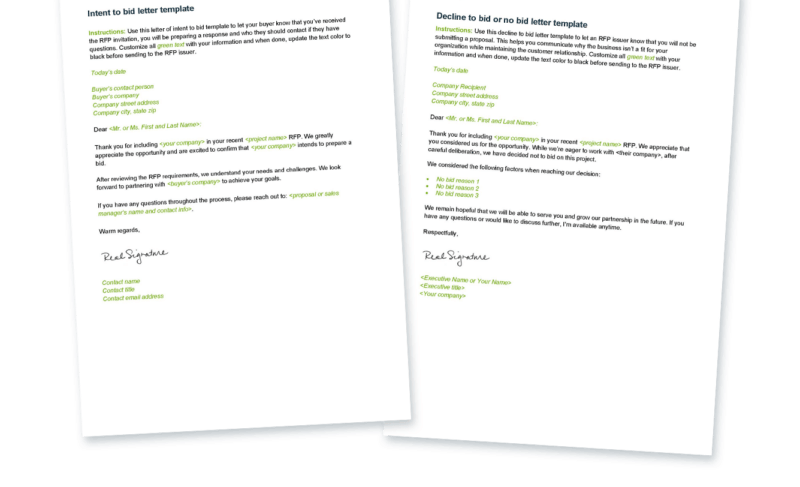For organizations focused on growth, answering every RFP is tempting. After all, each one represents an opportunity to win new business and generate revenue. However, not every RFP is created equal. And in some cases, responding to an RFP may not be the right move for your organization. So, how do you know the best way to spend your time? How do you separate promising RFP opportunities from those that are unwinnable or unwise? The answer is to add a bid/no-bid analysis step to your RFP response process.
The RFP response process requires an enormous investment of time and resources. Naturally, it would be best if those efforts were only focused on responding to RFPs that your business is sure to win. While there’s no way to ensure you win every RFP you respond to, you can quickly improve your win rate and save time by making a thoughtful bid or no-bid decision.
In this post we’ll discuss why carefully deciding to bid or not to bid is so important. Then, we’ll share three approaches to help you make a confident decision. In addition, we’ll offer key questions to ask and bid or no bid checklist examples. Finally, we’ll explore how to share your decision to bid or not to bid with the buyer along with letter templates to help you get started.
Basics and benefits using RFP go or no-go analysis
Bid or no bid defined
The process of evaluating whether to bid or not to bid goes by many names but is primarily referred to as the bid/no-bid or RFP go/no-go decision.
Simply put, in bid and proposal management, the RFP go or no-go process is a way to evaluate internal and external factors to determine if an organization should bid on an opportunity.
Benefits of holding go/no-go discussions
Responding to RFPs can win new business and help your organization grow, so why not just respond to all of them? Here are a few reasons why carefully considering which RFPs to bid on is important.
Lighten proposal team workloads and avoid burnout
Creating a winning proposal takes a lot of thought and time. So, creating a proposal for every RFP will inevitably result in wasted resources, a low win rate and an overworked, undervalued proposal team. In fact, a recent survey by Mairi Morrison with Strategic Proposals revealed that 62 percent of proposal professionals feel that their workload and volume of work are their greatest stressors.
A more selective and precise go/no-go process could significantly relieve the burden on proposal teams and prevent burnout. Bob Lohfeld, the CEO of Lohfeld Consulting Group has more than 30 years of experience in proposal management. In a Washington Technology article Lohfeld discusses the importance of RFP go or no-go decisions and believes they are the best way to improve your win rate saying:
“It is far quicker than hiring better people, improving poor proposal processes or investing in capture and proposal technology. In fact, making better bid decisions brings about an immediate improvement in win rate and, as an added bonus, lowers your annual cost of proposal development.”
Invest time wisely and improve win rates
Certainly, working strategically, improving your win percentage and reducing the cost of creating proposals is always important. However, making smart bid decisions becomes absolutely crucial when faced with big revenue goals. Despite this, many businesses seem to suffer from the fear of missing out when it comes to RFPs. Consequently, they spend resources and chase opportunities that aren’t a good fit. Lohfeld reframes the decision like this:
“Contrary to popular belief, the key to making good bid decisions is not picking the deals in your pipeline that you are going to win, but instead, it is discarding the deals that you are going to lose.”
If you knew you were going to lose, you wouldn’t waste your time preparing a proposal. Accordingly, the bid/no-bid process is about weeding out unlikely deals so you can better focus on the most winnable opportunities. Furthermore, a strong go or no-go evaluation process enables you to better forecast revenue and use available resources to your best advantage.
3 strategies for conducting bid/no-bid analysis
From business to business the RFP evaluation process will be different. However, this guide will help you create a go/no-go analysis that’s as simple or complex as your business requires. Certainly, the more objective you can be, the more accurate your decisions will become.
Basic: The core five go/no-go questions
The simplest and most straightforward way to determine if you should bid or not is to answer these five questions. Each question focuses on a factor that should be considered before proceeding.
- Big picture: Does this opportunity align with your business’s long-term goals?
- Capability: Is your business equipped to fulfill the RFP requirements? Can you meet the RFP deadline?
- Profitability: Will the project be profitable?
- History: Do you have content from a previous RFP in your proposal content library that will make answering this one quick and easy?
- Competition: Do you know who you’re competing against and can you win?
If you answer each question with a confident ‘yes’ then, go for it and happy bidding. On the other hand, if there are too many ‘no’ responses or caveats that start with ‘yes, but…’ or ‘yes, if…’ the opportunity may not be a fit.
This basic approach serves as a quick gut check before you devote time and resources to an RFP response. It is a great place to start for those new to bid/no-bid decisions. In addition, it works well for small- or medium-sized businesses where sales executives are responsible for proposal management. Another benefit of this short-form evaluation is that it can easily be conducted during a meeting with stakeholders if necessary.
Intermediate: True or false checklist
For those looking for a slightly more formal bid or no-bid analysis, the true/false checklist may be a good option. This form is still quick and easy to use, but considers the core five factors listed above in more detail. In addition, it can be customized to include the bid or no-bid criteria that’s most important to your business.
To gather your custom criteria:
- Examine past RFPs and identify common themes in those you’ve won as well as those you’ve lost.
- Ask for feedback from subject matter experts, business development and stakeholders — they may be aware of other factors you should consider.
- Define strengths and weaknesses that would heavily influence your likelihood of winning.
Now, to add your criteria to the checklist, simply phrase it as a true or false statement where true is the ideal answer. To keep the evaluation speedy, I recommend using no more than 20 true or false statements in your checklist. Once you’ve filled it out, tally up your affirmative answers and evaluate the recommendation to bid or not to bid. Generally, if there are more than 80 percent true statements, you’re in a strong position to bid.
This go or no-go analysis works well for businesses that have one or two dedicated proposal coordinators. It provides clear guidance and justification that will help to get everyone on the same page.
Bid or no-bid checklist template
This downloadable bid or no-bid checklist template includes some sample true or false statements to help you get started. Naturally, you’ll want to customize these to meet your organization’s needs. The standard considerations are broken into several sections. In addition, you’ll find templates for your next steps including an intent to bid letter and a no-bid letter.
Advanced: Bid/no-bid decision matrix
Math and data lovers, look no further than the bid/no-bid decision matrix for all of your analysis needs. The decision matrix approach uses a number of factors, rated on a scale to make a bid or no-bid determination. In some cases, each question or factor can also be weighted based on its importance to the business.
While this approach can get a little complicated, it’s helpful to teams who must consider many varying perspectives when making a go/no-go decision. In this scenario, each stakeholder completes the go/no-go matrix and shares the resulting score. Then, you gather the results and make your final decision by averaging the scores.
Bid/no-bid decision matrix examples:
Each question has three possible answers, each with a value:
1 – Unfavorable
2 – Neutral
3 – Favorable
A note about these tools
Remember, these checklists and worksheets are tools to help you make informed decisions. As such, they should evolve as your business needs and goals change. Regularly update the go or no-go criteria as you identify trends and better understand what works. If you use RFP software to respond to RFPs, explore how you can use the platform to accurately track workload considerations, win themes and more.

Next steps: Letter of intent or decline to bid
Now, you have your decision. What’s next? If the opportunity is a great fit, you’re good to go! Use an intent to bid letter to share the news with your buyer. Then move forward to the next step in your proposal timeline. Conversely, if you don’t plan to bid, you should notify the customer of your decision. Either way, we’ve got you covered.
It’s a go: Send a letter of intent to bid
Now it’s time to get down to business. But, before you start drafting your winning proposal, take a few minutes to send your prospect an intent to bid letter.

While typically not required, this handy little note lets the buyer know you’re excited to partner with them and you’re hard at work writing a perfect proposal. It also helps you stand out from the crowd, shows your thoughtfulness and high regard for them as a potential customer.
It’s a no go: How to respectfully decline to bid
We get it. This is awkward. No one likes rejection and it feels like a role reversal to tell a buyer that their RFP wasn’t a fit. At the same time, you want to be sure you maintain a good relationship for any future opportunities. So, here’s how you do it.
Write a no-bid letter
Communication is one of the most important things in a customer relationship. Accordingly, the decline to bid letter lets the procurement team know what to expect from your organization.
It is especially helpful for the issuer to know if you’re participating when the RFP has a small vendor pool. At the same time, the notice gives the customer the opportunity to follow up with you (and potentially offer helpful insight) before the RFP closes. In addition, sending the update will also save your inbox from unnecessary clutter as the RFP process moves forward and the customer sends new information to vendors still in the running.
When writing your letter, remember:
- Be as brief as possible.
- Offer insight about your decision, but stay positive.
- Provide your contact information for future opportunities.
- If you have an existing relationship with the customer, follow up with a phone call as well.
Final thoughts on the RFP go or no-go process
As you develop and implement your RFP bid or no-bid process, remember that no two RFPs are the same. Often, the difference between deciding to bid or not could come down to timing, staff availability, customer expectations, competition and so on. By adding a formalized go or no-go decision step to your RFP process, you can boost consistency, track success and better optimize in the future.
